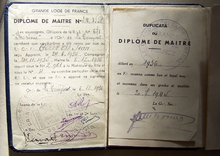Therefore sign
| Punctuation marks | ||||||||||||||||||||||||||||||
|---|---|---|---|---|---|---|---|---|---|---|---|---|---|---|---|---|---|---|---|---|---|---|---|---|---|---|---|---|---|---|
|
||||||||||||||||||||||||||||||
| In other scripts | ||||||||||||||||||||||||||||||
| Related | ||||||||||||||||||||||||||||||
|
| ||||||||||||||||||||||||||||||
In logical argument and mathematical proof, the therefore sign (∴) is generally used before a logical consequence, such as the conclusion of a syllogism. The symbol consists of three dots placed in an upright triangle and is read therefore. It is encoded at U+2234 ∴ THEREFORE (∴, ∴, ∴). For common use in Microsoft Office hold the ALT key and type "8756". While it is not generally used in formal writing, it is used in mathematics and shorthand. It is complementary to U+2235 ∵ BECAUSE (∵, ∵, ∵).
History
According to Cajori, A History of Mathematical Notations, Johann Rahn used both the therefore and because signs to mean "therefore"; in the German edition of Teutsche Algebra (1659) the therefore sign was prevalent with the modern meaning, but in the 1668 English edition Rahn used the because sign more often to mean "therefore".[1] Other authors in the eighteenth century also used three dots in a triangle shape to signify "therefore," but as with Rahn, there wasn't much in the way of consistency as to how the triangle was oriented; because with its current meaning appears to have originated in the nineteenth century. In this century, the three-dot notation for therefore became very rare in continental Europe, but it remains popular in the British Isles.[2]
Example of use
Used in a syllogism:
- All gods are immortal.
- Zeus is a god.
- ∴ Zeus is immortal.
- x + 1 = 6
- ∴ x = 5
Related signs

The inverted form ∵, known as the because sign, is sometimes used as a shorthand form of "because". This is Unicode character U+2235 BECAUSE.
The therefore sign is sometimes used as a substitute for an asterism ⁂.
In meteorology, the therefore sign is used to indicate moderate rain on a station model; the asterism indicates moderate snow.
To denote logical implication or entailment, various signs are used in mathematical logic: →, ⇒, ⊃, ⊢, ⊨. These symbols are then part of a mathematical formula, and are not considered to be punctuation. In contrast, the therefore sign is traditionally used as a punctuation mark, and does not form part of a logical formula.[3]
The graphically identical sign ∴ serves as a Japanese map symbol on the maps of the Geographical Survey Institute of Japan, indicating a tea plantation. On other maps the sign, often with thicker dots, is sometimes used to signal the presence of a national monument or ruins.
The character ஃ in the Tamil script represents the āytam, a special sound of the Tamil language.
In Masonic traditions the symbol is used for abbreviation, instead of the usual period, essentially an initial or monogram continuing the meaning of "therefore", 'standing for' i.e. "thus" (latin sic). For example "R∴W∴ John Smith" is an abbreviation for "Right Worshipful John Smith" (the term Right Worshipful is an archaic title just as "Land Lord" is and indicates that Brother Smith is a Grand Lodge officer).[4]
In Norwegian and Danish, a similar symbol is used as an explanatory symbol (forklaringstegnet). It can be typeset using the open o followed by a colon, thus: ɔ:. It is used for the meaning "namely", "id est", "scilicet" or similar[5].
See also
References
- ^ "Cajori, vol. 1, p. 211". Archive.org. Retrieved 2013-10-05.
- ^ Cajori, Florian (2011) [1929]. A History of Mathematical Notations: Two Volumes in One. Cosimo, Inc. pp. 282–283. ISBN 978-1-61640-571-7.
- ^ Stott, Jonathan. "Symbols - Mathematical Symbols". The Constants and Equations Pages – via Joint Institute for Nuclear Research.
- ^ Encyclopedia of Freemasonry Part 1 and Its Kindred Sciences Comprising the ..., Albert Gallatin Mackey, page 2, reprint in 2002, Kessinger Publishing, ISBN 0-7661-2650-1.
- ^ "Forklaringstegnet: en savnet del av det typografiske repertoar?" [Explanation: A missing part of the typographical repertoire?]. www.typografi.org (in Norwegian). Retrieved 2018-08-15.
